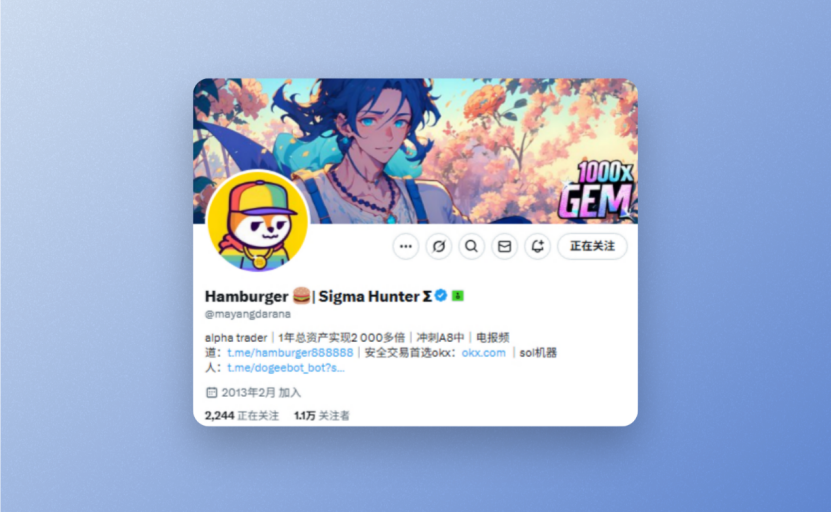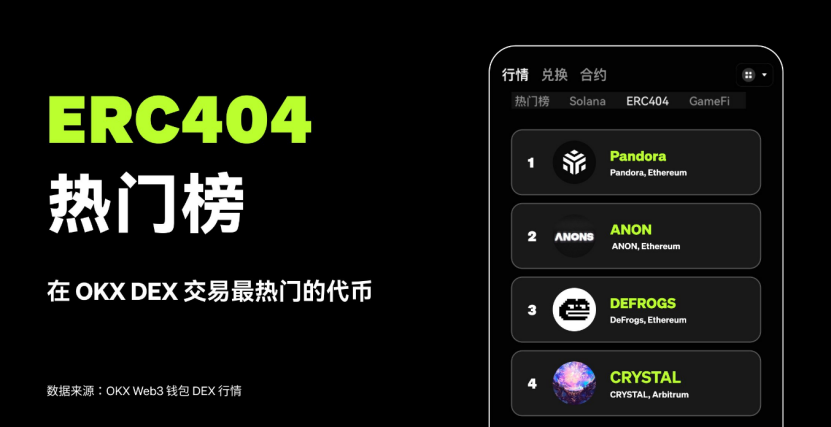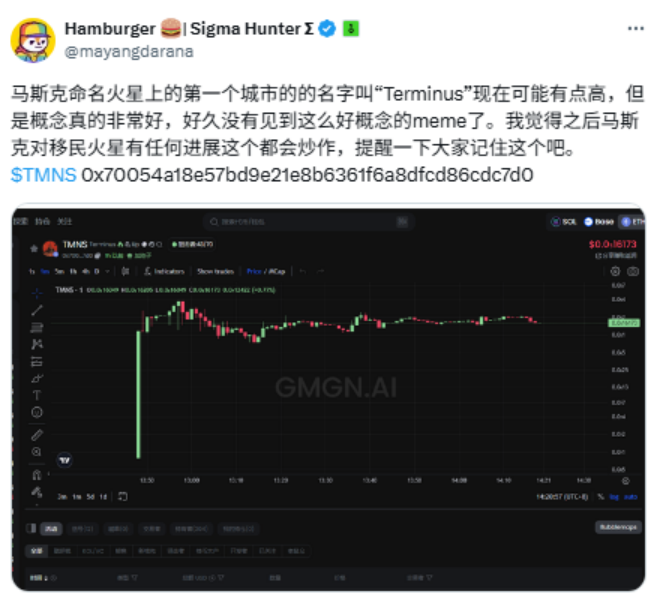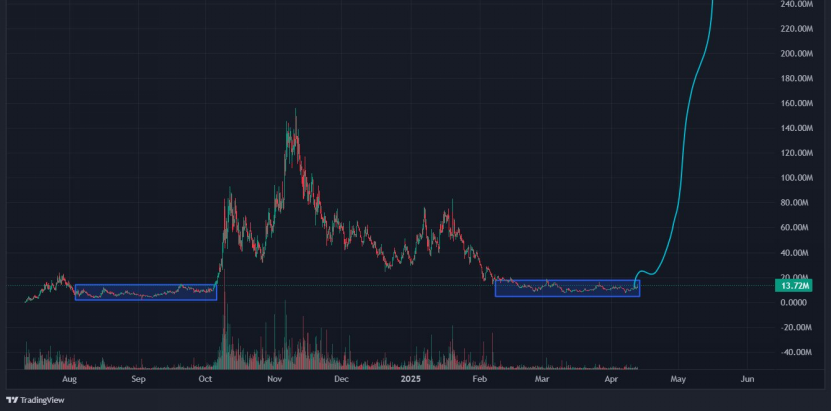
![]()
1. Could you please introduce yourself first?
Hello everyone, I am Hamburger. I started to get in touch with Web3 in October 2023. At that time, I was still in school. My roommate told me that I could make some money through Web3. Then I started to pay attention to this circle. I joined the circle with a try-it mentality, and achieved more than 2,000 times profit in one year.
2. Can you tell us about your past experiences?
When I first entered the circle, I invested about 2,000 RMB in capital. Like most newbies, I initially focused on the secondary market. After seeing some secondary bloggers on Twitter sharing their high-leverage profit cases, I also tried leveraged trading myself.
I remember when I first opened a contract, I saw a foreign BRC early builder tweeted that ORDI inscriptions were a scam. The market sentiment was very bad at the time, and everyone started selling ORDI after seeing the founder say so. I used more than 200 U in my hand to open a short position with a 10x leverage. At that time, ORDI fell very fast. Although I made a profit of more than 200 U in the early stage, I did not consider that everyone was optimistic about the fundamentals of the inscriptions at the time, and ORDI itself was a leading project. As a result, the market rebounded, and I went from a profit of 200 U to a loss of 30 U.
When I first entered the circle, I kept trying in the market. Although I lost a lot at the beginning, after several rounds of operations, I gradually began to accumulate some practical experience. It was not until March 2024 that my funds began to grow.
These are some of my experiences when I first entered the circle. Looking back now, it was completely a typical novice operation, but I did learn a lot from it.
Core content: When I first entered the circle, I invested 2,000 RMB, mainly playing in the secondary market, and also tried leveraged trading. When I first opened a short position in ORDI, I made a profit of 200U in the early stage, but due to misjudgment, I ended up losing 30U. Although I lost a lot in the early stage, I gradually accumulated experience and funds through continuous practice.
3. Can you tell us about what you are doing?
I am now mainly focused on the MEME market. Currently, I mainly pay attention to and participate in MEME projects on the Solana, ETH, Base and BSC chains. I hope to exercise my ability to judge MEME through continuous practical operations.
After so many attempts, I have my own thoughts. I think when participating in MEME coin, you must first have a basic understanding of its narrative. MEME coin is a great test of a person's ability to quickly judge and analyze projects, especially through Twitter, official websites and other channels to screen information and judge endorsements. This information constitutes the "endorsement" of MEME, and you need to have the ability to quickly identify and analyze the value of endorsements.
On this basis, learn to value the narrative and endorsement of the project. If you judge that the current market value of a project is far lower than its potential value and has at least ten times of room for growth, then you can choose to build a position at this stage. If you think it will not rise tenfold, it is not worth buying. You can wait and see, or look for the next target with more potential. Because when a MEME coin is in the FOMO stage, the market tends to overestimate the project, so a MEME coin with ten times of expected growth is a relatively ideal entry standard in my opinion.
With sufficient market liquidity, some less excellent stocks may have room for growth. However, the current market environment is not as good as that in November last year. Perhaps only very good stocks can bring us sustainable returns. Therefore, I think in the current market, we should adopt the strategy of "watch more and do less" and stay calm.
But this does not mean that you should not do anything at all. While being cautious, you should still make a few moves every day to ensure that you are not eliminated by the market or fall behind the development of the market. Only by going deep into a certain field, especially in the primary market, can you seize new opportunities when they arise.
Core content: I focus on MEME projects on Solana, ETH, Base, and BSC, and improve my ability to judge narratives and endorsements through practical operations. I think a project is worth buying only when it has more than ten times the potential. In the current market with weak liquidity, I insist on "watching more and doing less", maintaining a certain frequency of shots every day to ensure that I am not eliminated, and deepening the subdivided track to seize real opportunities.
4.What are your most memorable experiences in web3?
I remember when I first started to get involved in the primary market, the one that impressed me the most was Pandora of ERC-404. I had always been a small investor in the secondary market before, and I spent about 100-200U to buy Pandora. On the night of the purchase, its price doubled, tripled, quadrupled, and finally reached more than ten times. I successfully stopped the profit and earned several hundred U. At that time, I felt for the first time that the primary market was no longer a waste of time like the secondary market, but a place where people could achieve a small investment and a big return through on-chain operations.

After making some money from Pandora, I noticed the BOME project. I bought BOME when it was worth 10 million, but because I didn’t know much about MEME coins at the time, I sold it after it doubled. However, the wealth-making effect brought by BOME made me realize the potential of such projects. After that, I began to pay attention to some artists’ pre-sale projects and participated in the investment of other MEME coins. Through these early investments, I also got some relatively high returns.
These operations basically helped me build up my first wave of capital. Around May 2024, I came into contact with the Pump platform, especially Solana's Pump Fun launch platform. I began to use the strategy of small-scale bets for big gains with a small amount of 0.1-0.2 SOL to gradually try. At that time, the market liquidity was sufficient and there were relatively few scam projects. I slowly accumulated more experience and funds.
Core content: When I first came into contact with the primary market, the most impressive thing was Pandora's ERC-404 protocol. After investing a few hundred U, its price quickly doubled, and finally reached ten times. This made me realize the potential of the primary market. Then I paid attention to the BOME project, but I sold it because of my lack of knowledge, but this made me realize the potential of MEME coins. By May 2024, I began to try the Pump platform, using the strategy of small-scale betting and big-scale betting to gradually accumulate experience and funds.
5. Can you share with us the skills or areas in which you are good at?
I think I have a good grasp of the narrative of MEME. In August 2024, I was the first KOL in the Chinese area to call Mars City. I advised everyone not to rush to buy it, but to wait for its price to fall back, because I think the trend of this project is very grand. After all, this is the first time Musk has named a city on Mars, and he has been promoting the development of Mars. So I think Mars City is a project that is in line with the grand trend of human future, with strong attention and spreadability. This narrative is very attractive and can make people have a strong sense of identity and desire to spread.
I publicly stated that I would build a position in this project when its market value was about $20,000. Although I was washed out when the price later corrected, the performance of this target was still very good. Its market value rose from $20,000 to over $50 million, and the return reached more than 2,000 times.
It is actually very simple to judge whether a narrative has value. When you tell this story to others , is the other party willing to pay for it? For example, if you share a token with someone and tell him that the narrative of the token is "this dog is cute", then the spread of this token is relatively weak, because everyone's love for animals is different, and "cuteness" itself is not enough to make a person pay real money to buy a token.
In the early stages of a project, such a narrative may be able to generate some heat, but in the later stages, the narrative lacking strong communication power will appear weak.
I think a good narrative is one that makes you want to buy after you hear it, and when you tell it to others, it can impress them and even make them willing to buy it immediately. For example, the reason why I was optimistic about Mars City at that time was that it had a strong communication power. It was the first city on Mars and was named by Musk. Humanity’s yearning for space is a very grand narrative, and Musk’s development of another planet is an exciting long-term goal. This grand narrative made me willing to pay for it when it was worth tens of thousands of dollars. It is precisely this tellability and wide resonance that made me feel that it is very communicable.

Core content: I think I have a relatively accurate grasp of the narrative of MEME. I am the first KOL in the Chinese region to call Mars City, and I judge that it has a grand narrative value: Musk's naming, Mars development, and the future of mankind make it highly spreadable and resonant. This makes me more convinced that a good MEME narrative must have strong spreadability and the power to move people, and Mars City is a typical example of such a narrative that "others are willing to pay for it when you tell it."
6. Do you have any favorite track or token? Can you share the reasons why you are optimistic?
I think the current promising tracks are mainly concentrated in the primary market. The secondary market is not suitable for a small-to-big investment approach. It is more like a big-to-big investment, or a gambling market. Because many times, bloggers who rely on candlestick charts and K-line analysis often have their K-line charts broken by a sudden piece of news, causing the original trend to change.
On the contrary, the primary market is more like a place of fair competition. If you can see the opportunity earlier than others, understand the logic behind the narrative, and predict the market sentiment, then you can seize this wave of profits. This is also the charm of the primary market.
Core content: I am more optimistic about the primary market because it is more suitable for small-scale risk-taking. In contrast, the secondary market is more like risk-taking, even with the nature of gambling. The primary market is fairer. If you can find opportunities earlier, understand the narrative, and predict emotions, you will have the opportunity to seize profits. This is its charm.
7. How do you view investment or are there any investment methods you can share?
I think if you think too much about investment, it will affect your judgment. The simplest logic is to give a reasonable valuation based on the current market value after understanding the basic endorsement and situation of a project. If you think its valuation is far lower than its actual value, then you should buy it.
If you think its valuation is about the same, neither overvalued nor undervalued, or it is already overvalued, then you should give up this target and look for the next opportunity.
The most important thing is not to let technical indicators such as candle charts and K lines influence your judgment.
I personally think that the role of K-line is not particularly strong, and it can even be said that it is not even an auxiliary tool. It is more of an indicator of market sentiment. For example, a big positive line may represent the release of some good news, or people are enthusiastic about a project. But the K-line itself cannot accurately reflect whether a project is undervalued or overvalued, and it cannot even predict whether it will rise or fall in the future.
When we invest, we always focus on future prices. People buy a certain asset because they think it will rise in the future; and when they think it will fall in the future, they will give up the asset or choose to short it.

Generally speaking, it is recommended that the investment funds for each target should not exceed 10% of your total assets. The reason for this is that you can afford a maximum of ten failures. Try different targets more often and avoid concentrating all your funds on one project.
For example, if you have 400 U at the beginning, then your first investment should not exceed 40 U. If the first investment loses money, your second investment should not exceed 36 U. Always keep yourself "bullets" to play, because when you first enter the circle, many judgments may not be accurate, and luck also plays a big role.
The important thing is, as long as you can ensure that one of the ten targets can increase tenfold, then even if the other nine targets suffer losses, you can make up for the losses through the profitable target.
The initial goal is not to make money, but to use small amounts of money for trial and error and to exercise your judgment. Through these small investments, you can gradually develop your ability to discover opportunities.
Core content: I think investment does not need to be too complicated. The key is to see whether its current market value is far below the reasonable valuation. If it is undervalued, buy it, and if it is overvalued, give up. K-line is almost useless to me. It only reflects emotions and cannot guide investment. It is recommended to invest up to 10% of the total assets in each target. If there is a loss, reduce it proportionally to keep the "bullets" continuous. As long as one of the ten projects doubles tenfold, it can cover the losses of other projects. The early goal is not to make money, but to try and error and train judgment.
8. Do you have any questions you would like to share?
What I want to share is a suffix I recently added to my name - "Sigma Hunter". This is my expectation for the future, and it is also the positioning that a philosopher friend of mine has always asked himself to achieve. He invited me to join this concept, and I am very happy.
So what is a "Sigma Hunter"? I think it is difficult for ordinary retail investors to seize the opportunity of Alpha, that is, the most valuable things in a sector, such as Mubarak, which has been very popular on BSC recently. For example, in the early BBTC1 in the secondary market, many retail investors only realized their value after they rose. Therefore, it is difficult to become an "Alpha Hunter".
When an Alpha appears, many people will look for opportunities on Beta. Beta refers to a group of people who missed the Alpha opportunity in PVP. "Sigma Hunter" does not rely on these mainstream narratives, but discovers independent narratives that others have not noticed outside of these narratives and seizes them at an early stage.
I think the spirit of "Sigma Hunter" is that even though I missed the first Alpha, I didn't participate in the Beta concept of PVP, but instead went looking for a brand new and unique Sigma concept.
I hope everyone can become a "Sigma Hunter". If you want to grow into a "Sigma Hunter", I think everyone can go deep into it when a target rises, especially when there is a very unique narrative behind this target. Although you may miss the first wave, understanding the concept behind it is to discover the next trend in the future.
For example, when I first saw the Mars City, I hardly saw anyone paying attention to the project. I think the Mars City concept is a successful discovery of mine as a "Sigma Hunter".
Core content: I recently added "Sigma Hunter" to my name, which is my expectation for the future. Alpha opportunities are hard to catch, Beta is PVP after missing Alpha, and what I pursue is a Sigma narrative that is independent of the mainstream. Finding unique opportunities when others haven't noticed it, such as the Mars City I discovered early, is a successful attempt of mine as a "Sigma Hunter".
9. Can you give some advice to newbies in the industry?
For newbies, my suggestion is that 90% of the KOLs on Twitter should be blocked. Because the audience of these KOLs is usually newbies, and their content is often designed to attract newbies to participate in high-risk projects. Their goal is to make you see their content and profit from it. For example, if you register a new Twitter account and click on the Web3 section, you will most likely see a lot of "get-rich-quick" stories, which are basically designed to attract newbies.
We should try to avoid following these KOLs. Instead, we can use some methods to filter out high-quality content. For example, you can find those early adopters to see who first discovered this narrative and follow their Twitter, so that you can filter out more valuable content. Learn to streamline the information you receive and block out low-quality content.
In terms of mentality, it is recommended to maintain a conservative attitude when you first enter the circle and do as little as possible. Don't be tempted by other people's stories of getting rich quickly, avoid blindly joining paid groups or doing things you don't understand. Keep the desire to get rich quickly, but more importantly, learn more and gradually accumulate experience.
Core content: When you first enter the circle, I suggest you block 90% of the KOLs on Twitter. Most of their content is designed to attract newbies to participate in high-risk projects. In contrast, I prefer to pay attention to those who really discovered the project early and get valuable information from them. At the same time, you should streamline the information sources and block low-quality content. In terms of mentality, don't be tempted by stories of getting rich quickly, avoid blindly following the trend, and the key is to learn more and accumulate experience.
【Web3 Profile】Web3's first personal interview platform, deeply explores the stories behind 100 KOLs, fund founders, entrepreneurs, and builders in the industry, focusing on their experience in the cryptocurrency circle and their growth experience, and focusing on exploring their personal experience. It is committed to making the personal experience of the interviewees shine and showing the most authentic growth stories of the people.
Disclaimer: [Web3 Profile] disseminates content with a neutral attitude. This article does not constitute any investment advice and is for reference only.











